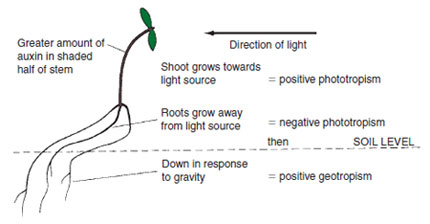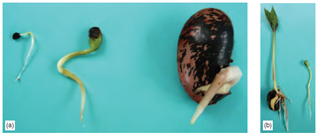The seeding
Content
Within the seed is a food store that provides the means to produce energy for germination. Once the food store has been exhausted, the seedling must rapidly become independent in its food supply and begin to photosynthesize. It must therefore respond to stimuli in its environment to establish the direction of growth. Such a response is termed a tropism, and is very important in the early survival of the seedling (Figure 11.2). Geotropism is a directional growth response to gravity. The emergence of the radicle from the testa is followed by growth of the root system, which must take up water and minerals quickly so that the shoot system may develop. A seed germinating near the surface of a growing medium must not put out roots that grow on to the surface and dry out, but the roots must grow downwards to tap water supplies. Conversely, the plumule must grow away from the pull of gravity so the leaves develop in the light.
Etiolation is the type of growth which the shoot produces as it moves through the soil in response to gravity. The developing shoot is delicate and vulnerable to physical damage, and therefore the growing tip is often protected by being bent into a plumular hook. The stem grows quickly, is supported by the structure of the soil and therefore is very thin and spindly, stimulated by friction in the soil which causes release of ethylene. The leaves are undeveloped, as they do not begin to function until they move into the light. Mature plants that are grown in dark conditions also appear etiolated.
Seedling development The emergence of the plumule above the growing medium is usually the first occasion that the seedling is subjected to light. This stimulus inhibits the extension growth of the stem so that it becomes thicker and stronger, but the seedling is still very susceptible to attack from pests and damping-off diseases. The leaves unfold and become green in response to light, which enables the seedling to photosynthesize and so support its development. The first leaves to develop, the cotyledons, derive from the seed and may emerge from the testa while still in the soil, as in peach and broad bean (hypogeal germination), or be carried with the testa into the air, where the cotyledons then expand (epigeal germination), e.g. in tomatoes and cherry. Phototropism occurs so the shoot grows towards a light source that provides the energy for photosynthesis. A bend takes place in the stem just below the tip as cells in the stem away from the light grow larger than those near to the light source. A greater concentration of auxin in the shaded part of the stem causes the extended growth (see Figure 11.2). Roots display a negative phototropic response, growing away from light when exposed at the surface of the growing medium, e.g. on a steep bank. The growth away from light may supersede the root’s geotropic response, and will cause the roots to grow back into the growing medium. Hydrotropism is the growing of roots towards a source of water. The explanation of this tropism has not been found, but it can be shown to occur. The cotyledons that emerge from the testa contribute to the growth of the seedling in photosynthesis, but the true leaves of the plant, which often have a different appearance to the cotyledon, very quickly unfold. Apical dominance After the germination of the seed, the plumule establishes a direction of growth, due partly to the geotropic and phototropic forces acting on it. Often the terminal bud of the main stem sustains the major growth pattern, while the axillary buds are inhibited in growth to a degree that depends on the species. In tomatoes and chrysanthemums, the lateral shoots have the potential to grow out, but are inhibited by a high concentration of auxin, which accumulates in these buds. The source of the chemical is the terminal bud, which maintains the inhibition. In commercial chrysanthemum production, the removal of the main shoot (stopping) is a common practice. It takes away the auxin supply to the axillary buds, which are then able to grow out to create a larger, more balanced inflorescence. Conversely, the practice of disbudding in chrysanthemums and carnations, takes out the axillary buds to allow the terminal bud to develop into a bigger bloom that benefits from the greater food availability. Conditions for early plant growth Many plant species are propagated in glasshouses. A few principles are described here to help ensure success. Seed trays should be thoroughly cleaned to prevent the occurrence of diseases such as ‘damping off’. Fresh growing medium should be used for these tiny plants that have little resistance to disease. Compost low in soluble fertilizer is less likely to scorch young plants. Compost should be firmed down in containers to provide closer contact with the developing root system. With very small seed there is a danger that too many seeds are sown together, with the result that the seedlings intertwine and are hard to separate. This problem can often be avoided by diluting batches of very small seed with some fine sand before sowing. Small seed samples need to be sown on the surface of the compost and then covered with only a fine sprinkling of compost. In this way, their limited food reserves are not overtaxed as they struggle through the compost to reach the light. Water quality is important with young plants. Mains water is recommended, as it will be free from diseases. Water butts and reservoirs need particular scrutiny to avoid problems. Water that has been left to reach the ambient temperature of the glasshouse is less likely to harm seedlings. The compost in seed trays should be kept permanently moist (but not waterlogged), as seedling roots dry out easily. Glass or plastic covers placed over seed trays will help prevent moisture loss, and these can be removed when root establishment has occurred and seedlings are pushing against the covers. As soon as seedlings have expanded their cotyledon leaves, they should be carefully transferred (‘pricked off’) from the seed tray and placed in another tray filled with compost having higher levels of fertility. The seedlings should be spaced at approximately 2.5 cm intervals, thus providing a root volume for increased growth. Later, plants will be transferred to pots (‘potted-on’) to allow for further growth. Plants growing in glasshouses are tender. The cuticle covering leaves and stems is very thin. Growth is rapid and the stem’s mechanical strength is likely to be dependant on tissues such as collenchyma and parenchyma rather than the sturdier xylem vessels. When a plant is transferred from a glasshouse to cooler, windier outside conditions (for example in spring), it may become stressed, lose leaves and stop growing. It is advisable to ‘harden off’ plants before this stressful exposure. Reducing heat and increasing ventilation in the glasshouse are two ways of achieving this aim. Traditionally plants were moved out into cold frames to gradually expose them to the conditions into which they are to be planted. Moving plants out during the day and back inside overnight for a number of weeks, is another strategy. |
||||||||||||||||||||||||||||






